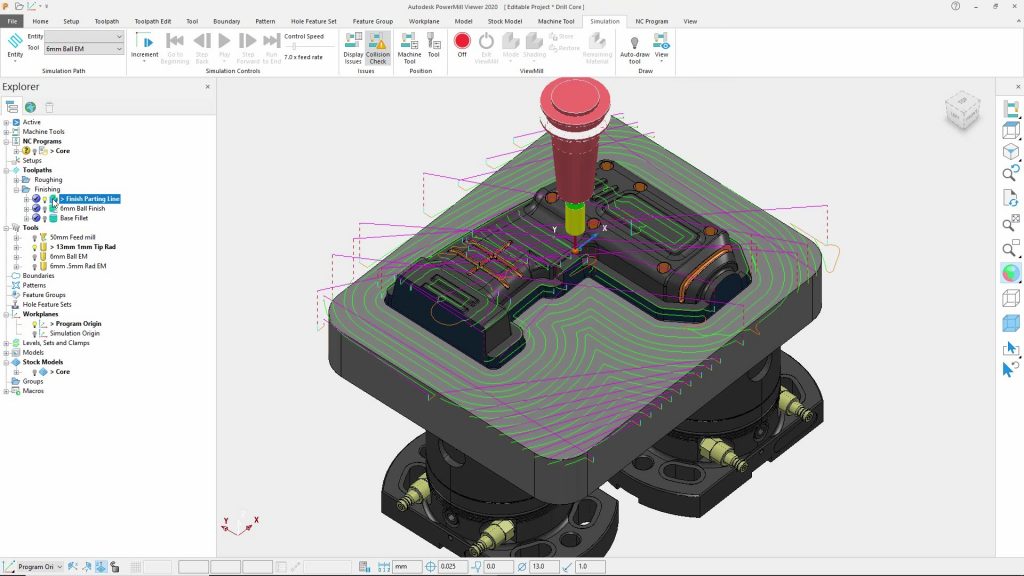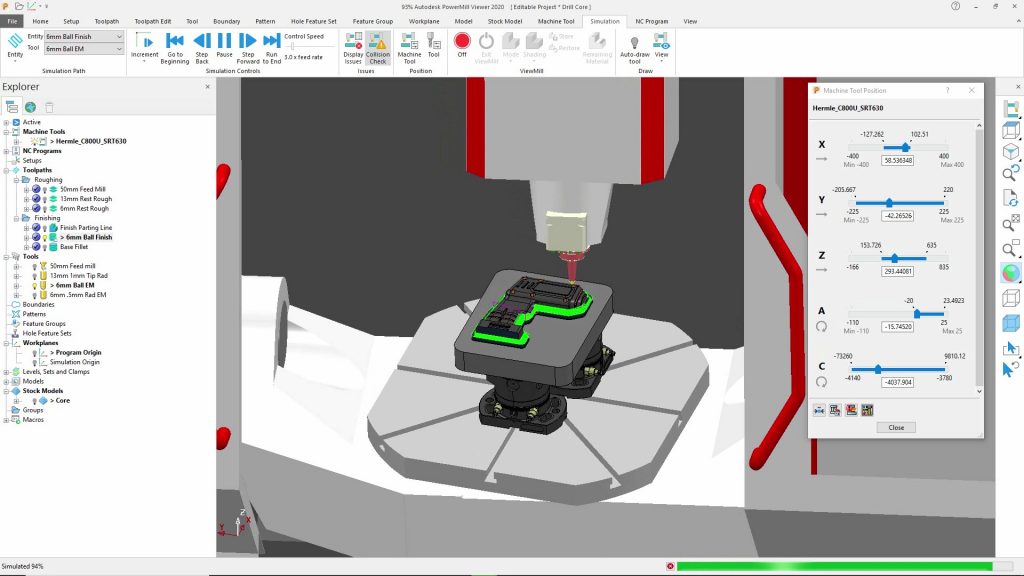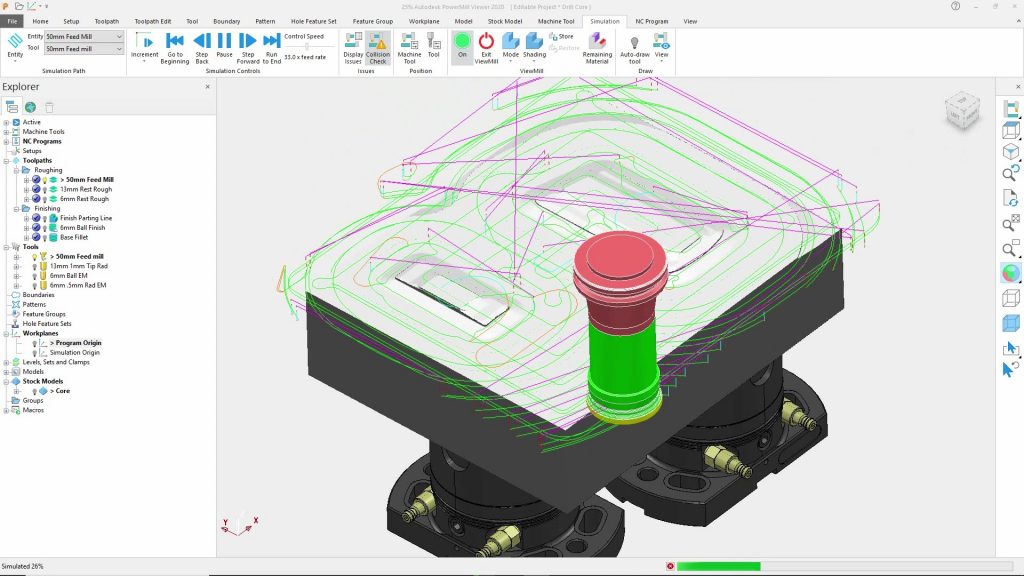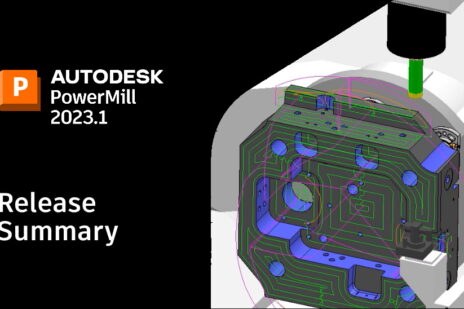
Article by Clinton Perry, PowerMill Product Marketing Manager
It only feels like yesterday when Autodesk released PowerMill 2020.1, with its enhanced usability, new model filleting tool, and faster calculation speeds (check out this blog post if you missed the 2020.1 update). Yet here we are, nearing the end of 2019, and guess what, PowerMill 2020.2 is hitting the streets already!
So what does this release include and, more importantly, what does it mean to you? As well as the usual mix of bug fixes and usability improvements, the biggest change sees the introduction of a new PowerMill Viewer. Essentially, the Viewer is a feature-restricted application that you can install on multiple computers at no additional cost. PowerMill Viewer allows users to open existing PowerMill projects and examine their contents. The Viewer provides all of PowerMill’s capabilities to simulate and verify toolpaths and NC programs. Crucially, the Viewer does not allow users to save or export any data – meaning models, NC programs, setup sheets, macros and so on cannot be saved to disk.
PowerMill Viewer helps teams to collaborate
The real goal of the Viewer is to allow more users within your organization to have the ability to access your PowerMill data, and do so without the need to purchase additional licenses. Let’s consider a few scenarios and see how the Viewer can help you and your manufacturing business.
PowerMill Viewer scenario 1 – The machine tool operator
In some companies, the CAM programming is carried out by a dedicated engineer in an office environment. Once completed, the finished NC programs and setup sheets are then sent to a machine operator to start machining. In these cases, the machine operator often needs to review the machining process to better understand the machining setup, datum positions, tooling to be used, as well as having an idea of the machining process that is about to be run. If you’ve ever run someone else’s NC programs, you know that it can be a little scary when you’re not sure exactly what the machine is going to do. The goal of the Viewer is to allow the machine operator to have the confidence to run the process, knowing everything is safe and OK.

The Viewer allows the machine operator to open the PowerMill project and then carry out a number of different checks, including:
- Reviewing the machining setup
- Checking datum positions
- Confirming the size of the block to be machined
- Reviewing the toolpaths that will be run on the machine
- Simulating stock removal with ViewMill
- Identifying un-machined stock
- Checking for collisions or near-misses
- Simulating NC programs using a 3D model of the CNC machine tool
- Validating tool assemblies to check that the right holder assembly is being used
- Exploring if alternative tooling could be used (possibly to reduce tool length)
- Checking the overall machining process
- Estimating machining cycle times
- Having the confidence to press cycle start
While the machine operator cannot save the PowerMill project or export data (such as modified NC programs) they can use the Viewer to identify problems before starting the machining operation. This allows them to raise any issues with the CAM programmer earlier in the process and avoid costly delays once the machining has begun.

PowerMill Viewer scenario 2 – The operations manager
In many manufacturing companies, there is often an individual who has responsibility for managing the day to day activities on the shop floor. This “operations manager” is unlikely to want to review PowerMill projects in great detail, but they may want to be able to check high-level information that can impact daily production. Often they will need to find answers to common questions, including:
- What raw materials are needed?
- The Viewer allows the operations manager to determine what shape and size of block will be needed. This helps them to source raw materials either from existing stocks or by placing orders with external suppliers in time to meet production needs.
- How many machining setups will be required to produce the part?
- The Viewer allows the operations manager to quickly review the overall machining process, to understand if/when a part will need to be transferred to a different fixture setup or to a separate machine.
- What tooling is being used?
- The Viewer provides access to a list of all tool assemblies needed, allowing the operations manager to check that sufficient tools and consumables (inserts) are in stock or to place orders for additional tools from their supplier.
- What machine will be required?
- The Viewer allows the operations manager to see what machine(s) are being used to produce a given part. This gives the operations manager some insight and helps with overall production scheduling.
- What are the predicted machining cycle times?
- The Viewer provides estimated cutting times for toolpaths and NC programs, allowing the operations manager to better understand how long a given part will take to produce, and when it might be ready to deliver to the end customer.
The PowerMill Viewer provides access to key information allowing the operations manager to have much better insight into the projects being processed at any given time – and to do so without having to purchase an extra PowerMill license.
PowerMill Viewer scenario 3 – The sales representative
In any manufacturing company, the sales team plays a crucial role in driving new business and customer relations. These sales representatives will often be the first to meet with clients to discuss their specific needs. The sales team is also in a unique position as it has an awareness of the capabilities of the manufacturer – e.g. what type of CNC machines they own, what size parts can be produced, as well as knowing what work-holding and tooling may be available.

The Viewer provides a tool that sales representatives can use during discussions with clients either during quotation stages of projects, or at a later time when projects are being reviewed. The Viewer enables the sales representative to carry out common tasks, such as:
- Importing customer CAD models to review their size, shape, and complexity
- Deciding which CNC machine tool should be used (e.g. 3-axis or 5-axis, milling or turning)
- PowerMill’s “Dynamic Machine Control” feature allows the CAD model to be placed onto the table of a virtual CNC machine tool. Once in position, the DMC can be used to dynamically position the cutting tool on the model to check how easily the part can be machined – e.g. will the part fit on the machine, will there be axis over-travel issues that could complicate machining
- Confirming if the part can be produced in a single setup/machine or if multiple processes will be required
- Using PowerMill’s “Undercut shading” to identify features that will need 3+2 or 5-axis machining
- Using “Minimum radius” shading to identify small corner radii or detailed features that may require the use of very small cutters, or EDM (electrical discharge machining)
- Planning work-holding options and the impact this has on the machining process
The Viewer helps the sales representative to better understand the challenges of machining the customer’s part. This helps them to produce more accurate estimates for programming and machining the parts, giving them greater confidence that projects will be delivered on-time, to budget, and producing an acceptable profit margin.
Summary
The PowerMill Viewer allows stakeholders within your organization to collaborate more effectively. More members of your team now have access to better insights into the CNC machining elements of your manufacturing process. This allows better decisions to be made sooner in the process and can help reduce or prevent mistakes or miscommunications from happening. The Viewer really should allow your company to do more, do it better, and spend less time doing it.
How do PowerMill customers access the Viewer?
This latest PowerMill update is being released starting 28th November 2019.
Eligible customers with an active subscription or maintenance agreement can download the latest release using the Autodesk Desktop App or by logging into their Autodesk Account. To access the viewer, download and run the 2020.2 update to install onto your PC. Once the installation has completed, select the Windows Start icon (bottom left corner of the screen) and then click “Autodesk PowerMill Viewer”.
Can I install the Viewer on other PCs?
Absolutely, yes! As a PowerMill subscriber, you can install PowerMill 2020.2 onto other PCs within your organization. Simply install the full version of PowerMill 2020.2 on to the PC, and then select the Windows Start icon followed by “Autodesk PowerMill Viewer”. It’s important to remember to run the Viewer and not the full version of PowerMill 2020.2, as this will ask you to enter your license details – which could result in licenses not being available for other PowerMill users within your organization.
I’m not a customer, how do I learn more about PowerMill and the PowerMill Viewer?
If you’re new to PowerMill you can learn more by visiting www.autodesk.com/powermill.
Free evaluation
Want to evaluate PowerMill and see how it can help you solve your toughest CNC machining challenges? Contact our team of manufacturing specialists at www.autodesk.com/powermill-evaluation to learn more.



Add comment
Connect with: Log in
There are no comments